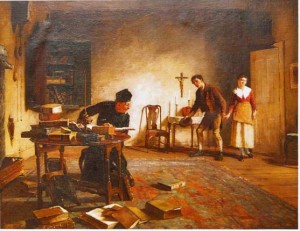Catholic parish registers
Published in Features, Issue 2 (March/April 2015), Volume 23
Candidates for Marriage or The Cleric’s Interruption by Howard Hemlick (1881). As a general rule of thumb, the original Catholic parish registers remain in the custody of the local parish priest. (Private collection)
The Roman Catholic Church in Ireland was a private institution. The Catholic clergy had pastoral duties towards their community but no civil responsibility. From the late eighteenth century, Catholic religious orders involved themselves more in education and welfare, founding specifically Catholic schools and institutions (reformatories, industrial schools, orphanages, asylums and refuges).
The basic administrative unit of the Catholic Church was the parish, grouped in dioceses. After Catholic Emancipation (1829) the Church reorganised its parish structures to accommodate the huge population growth of the previous century. The greatest number of Irish Catholic parish registers date from this time. Consequently, it is possible to trace almost all Catholic Irish families back to the 1830s. There are some earlier parish registers, especially for the larger towns.
Local custody
As a general rule of thumb, the ori-ginal parish registers remain in the custody of the local parish priest. Consequently the records are very dispersed. The National Library of Ireland (NLI) tried to remedy this and made microfilm copies of almost all Catholic parish registers in Ireland with a cut-off date of 1880. A list of all parish registers available on microfilm in the NLI is available here: http://www.nli.ie/en/parish-register.aspx. The parishes are listed alphabetically by diocese, and include the start and finish dates of the records. If you’re not sure which diocese the parish you’re searching for is in, Google it.
The Catholic Church records are mainly baptismal and marriage records. The Church of Ireland was responsible for burying the dead of all denominations in its catchment, but didn’t always record the burials of other faiths. A minority of Catholic parishes kept burial registers, but you will have to check on a case-by-case basis. The language used in the registers is predominantly English; a minority used an abbreviated form of Latin.
Baptismal records
Baptisms were kept in ledgers in a clerical ‘free form’. The minimum genealogical information includes the date of baptism, the name of the child, the child’s father’s full name, the mother’s Christian name and the name of the godparents (sponsors). As the nineteenth century progressed, more information was set down, including the date of the child’s birth if it differed from the date of baptism, the mother’s full maiden name and the townland address. By the early twentieth century, many (but unfortunately not all) Catholic priests made marginal notes next to specific baptismal records, to make a note where someone born in the parish married outside of the home diocese, usually overseas. This information was received in the home parish by letter, sent from priest to priest, to verify that a prospective bride or groom was a baptised Catholic.
Marriage registers
Information recorded in Catholic marriage registers also changes in the nineteenth century. The early ones usually include the full names of the bride and groom, their townland address and their witnesses. By mid-century many include the name of the bride and groom’s fathers. By the 1870s a small but significant minority of mainly Dublin parishes further include the bride and groom’s mothers’ full maiden names.
Burial registers
Where a Catholic parish kept a burial register, it was often for a limited time-span before being discontinued. The information recorded is minimal, typically the name and age of the deceased. The NLI recently created new digital images of the Catholic parish registers. In summer 2015 the Library will place these images on-line, but without an index. Now watch the scramble between Findmypast, Ancestry and FamilySearch as they rush to be the first on-line with a complete index to these records. It will transform access to these registers beyond recognition.
Fiona Fitzsimons is a director of Eneclann, a Trinity College campus company, and of findmypast Ireland.
















